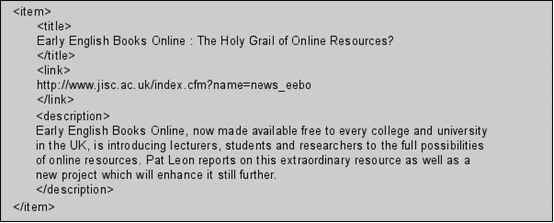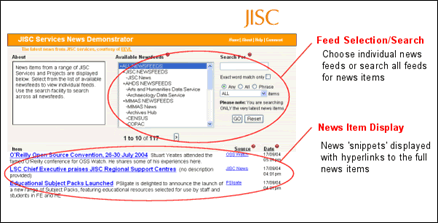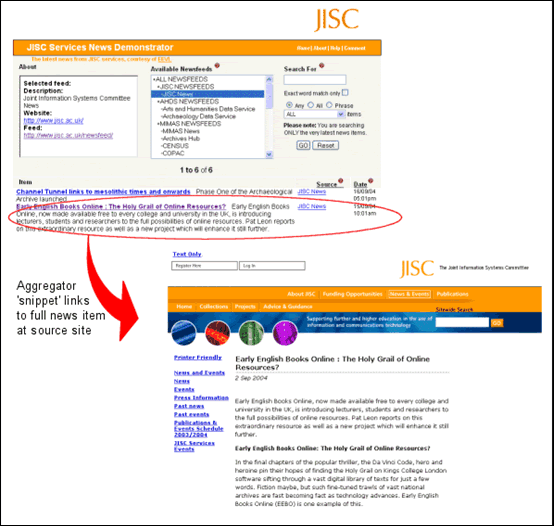Improving Communications Within JISC through News Aggregation
JISC currently funds thirty-four services across the UK. These can be divided into Network Services (e.g. JANET), Content Services (e.g. BizEd, BUFVC), Development Services (e.g. TechWatch, UKOLN), Support Services (e.g. Regional Support Centres) and Expert Services (e.g. JISC Legal). The people and communities that they serve are varied, but what unites them is that, through JISC-funding, they all carry out some function which supports the needs of UK Further and Higher Education and research. A problem for people working for a JISC Service, for the JISC Executive or indeed for those amongst projects funded by JISC, is one which is faced by any distributed organisation. The issue relates to effective communication, targeted to ensure that the right people are informed about issues that matter to them. We detail how a pilot project, called JISCnews Pilot, being undertaken by JISC might provide some solutions to effective internal communication, the cultural steps needed to ensure its success, and some insight into the technology which has been developed to ensure objectives are met.
Starting Point: Audit of the Present Environment
In December 2003, JISC created a dedicated Communications and Marketing team. Concurrently, a more strategic approach to increasing JISC's media profile was initiated. JISC wanted to demonstrate, even more effectively, how the tactics needed to fulfil this approach required an overlying strategy which would ensure ease of use, a motivated rationale for getting involved, and occasionally the requirement to stand back and blow a trumpet or two. JISC Services play a vital role in ensuring that the JISC can communicate consistent messages about its activities to the press and key audiences, such as funding councils, government bodies, agencies and staff and students from institutions. These messages need to be timely, focused and consistent, whether at the local, regional, national or international levels. Just as importantly, Services should be encouraged to realise how they contribute, as part of a unique, distributed entity, to improving the education experience of over six million people and growing.
JISC invited representatives from its funded services to form a News Working Group, whose main aim was to examine the cultural and technical requirements of pooling news about service activity. The intention was to encourage services to identify opportunities in running events with other services, targeting the press, ensuring important activities are reported on the JISC and other Web sites and raising the standard of news items and features.
One of the first tasks addressed by the group was to examine what media was presently being used to disseminate news internally (between services) and externally (to audiences served within the community). The group were looking for a mechanism that brought news together in a simple way, in one place. Newsletters, JISCmail lists and standard email messages all serve their purpose, but one means of collation that stood out was Really Simple Syndication (RSS), the main advantage of the technology being that items are added, updated and deleted dynamically. Several of the RDN Hubs use RSS to disseminate news items and have done so for a number of years. It was by luck that Roddy MacLeod, (EEVL Manager) and his colleagues Malcolm Moffat (EEVL Project Officer) and Geir Granam (EEVL Technical Officer) had already developed software which could aggregate news feeds into one place. This software is used to deliver EEVL's popular OneStep Industry News [1] and OneStep Jobs [2] services. There were potentially a number of advantages to adopting an enhanced and further developed version of this technology for the purpose of achieving one of the group's main aims: to bring news items together from various services.
RSS and the JISCnews Aggregator
RSS is an XML format which allows the easy sharing of snippets of content. For more information about RSS, see EEVL's RSS Primer [3]. The snippets themselves normally consist of a headline/title and a brief description. A hyperlink from the headline/title leads to the full news item, which is often a more detailed press release at another part of the Web site. Snippets from a source are collectively referred to as a 'feed' or 'news feed'.

Figure 1: A typical RSS news item
RSS feeds can be viewed in a number of ways. Traditionally, the standard method has been through a desktop reader, but it is also possible for them to be viewed via the Web. In addition, different RSS feeds can be aggregated together on one Web site, and this is what the OneStep Industry News and OneStep Jobs services do.
Whereas a general aggregator such as Bloglines [4] provides Web access to a very large number of RSS feeds on all subjects and from thousands of sources, EEVL's OneStep services concentrate on two particular topics (industry news in engineering, mathematics and computing, and job announcements in the same subject areas) and features only specially selected feeds relevant to those topics. The RSS feeds being aggregated are produced by a number of different 'sources'. In the main, these are publishers, or in the case of OneStep Jobs, recruitment agencies. Visitors to the Web site of the OneStep aggregators can, thus, scan the latest industry news items or job announcements from various top sources; if one or more particular snippet looks of interest, they can easily click through to the full item, and later return to the aggregator to scan for more snippets of interest. For more information see 'RSS and EEVL: Syndicating industry news and job announcements' in Ariadne 37 [5].
It was this technology which was further developed by EEVL in line with the News Working Group specifications, in order to make it suitable for a JISCnews aggregator featuring feeds produced by various JISC Services. The JISCnews aggregator therefore allows those with access to the service (currently restricted to staff of JISC, JISC Services and JISC projects) to scan the latest news from those services easily, on one Web site.

Figure 2 : JISC News aggregator displaying all newsfeeds
The news item displays, shown in Figure 2 and Figure 3 below, illustrate how the headlines and corresponding descriptions provide fast access to news items. Services and JISC can quickly monitor what is happening within the JISC community. The JISC News headline and description about Early English Books Online shown in Figure 3 linked to a more extensive item published on the JISC Web site.

Figure 3: JISCnews Aggregator Linking to full text news item
Several enhancements to the fairly basic software behind the original OneStep services were required for the Pilot. The default display for EEVL's OneStep services intermingles snippets from each source, ensuring that one snippet from one source is followed by another snippet from another source, giving each content provider equal exposure overall. This was not suitable for the JISCnews service. Instead, the requirement was for a chronological default display, to ensure that the most recent news items produced by any of the sources (the JISC Services) appeared at the top of the list of items (see Figure 2). This was also important because in some cases, for example with that of the smaller JISC Services, fresh news items might only be added to a feed on an irregular basis, and without this enhancement the JISCnews aggregator might have given undue prominence to dated news items submitted by other Services.
Enhanced search capability and phrase searching were the next features to be added. The database behind JISCnews is relatively small (the size varies according to how many snippets are produced by the services, but is unlikely to be more than a couple of hundred items). As long as this is born in mind, searching can be a useful way to find items of interest.
If a service produces relatively infrequent news snippets, it is possible that their most recent item included in the aggregator might be a few weeks old. This in itself causes no problems, but to enable retrieval of only the latest snippets, a drop-down filtering option was added which allows retrieval of only those snippets added in the last twenty-four hours, or in the last seven days.
To ensure currency, which is obviously very important for a news service, all RSS feeds are harvested hourly.
As an experiment to see whether it might prove useful in some circumstances, a weekly email accumulation of newly added news items is produced automatically. This is sent to Paul Davey, who is managing the Pilot (for details of the Pilot see below), and can be forwarded to others within JISC on request.
A further requirement was to enable monitoring of snippets being added to the aggregator and, if necessary, permit their deletion. This was achieved through the creation of an administration interface, which facilitates not only monitoring, but also allows new RSS feeds to be added and edited.
The JISCnews software has great potential for use by other JISC services, or indeed anyone, either in an intranet, or as a public service aggregating content on a particular topic or resource type, etc. 'RSS: less hype, more action' [6] examines a number of such ideas for RSS aggregation. The final requirement was therefore to enable the downloading of the JISCnews software and provide instructions for Webmasters who may want to configure it in various ways. Initially, this software will be made available to JISC Services, but may be released at a later date for public use.
Services Included in the JISCnews Aggregator
JISC are encouraging all Services to submit a feed for the aggregator. At present the following have produced feeds:
- The Arts and Humanities Data Service (http://www.ahds.ac.uk)
- The Archaeology Data Service and the Arts and Humanities Data Service Archaeology (http://ads.ahds.ac.uk/)
- Biz/ed (http://www.bized.ac.uk/)
- British Universities Film Council (http://www.dur.ac.uk/its/software/graphics/BUFC/)
- MIMAS data centre (http://www.mimas.ac.uk) and services it hosts:
- Archives Hub (http://www.arhiveshub.ac.uk)
- CENSUS (http://census.ac.uk/cdu/)
- COPAC (http://copac.ac.uk)
- ESDS International (http://www.esds.ac.uk/international/)
- jstor (http://www.mimas.ac.uk/jstor/)
- Spatial Data (http://www.mimas.ac.uk/spatial/)
- Web of Knowledge (http://wok.mimas.ac.uk)
- ZETOC (http://zetoc.mimas.ac.uk/)
- Resource Discovery Network (http://www.rdn.ac.uk/news/) and some representative hubs:
- EEVL (http://www.eevl.ac.uk)
- PSIgate (http://www.psigate.ac.uk)
- BIOME (http://www.biome.ac.uk)
- Virtual Training Suite (http://www.vts.rdn.ac.uk/)
- EDINA data centre (http://www.edina.ac.uk)
- Cetis (http://www.cetis.ac.uk)
- JISCmail (http://www.jiscmail.ac.uk)
- OSS Watch (http://www.oss-watch.ac.uk)
- UKOLN (http://www.ukoln.ac.uk/)
Production of RSS feeds
RSS feeds can be produced in various ways, both manually and automatically. Online editors exist which can produce an RSS channel simply by filling in an HTML form with no code writing required. Examples include UKOLN's RSSxpress channel editor [7] which creates RSS 1.0 feeds and the RSS Channel Editor from WebWeference [8] which creates RSS version 0.91 feeds. Once created, these feeds can be saved locally and uploaded to a Web server for public use. For feeds which change on a regular basis such manual updating may be cumbersome and it may be more appropriate to generate RSS automatically from a database or content management system. The EEVL RSS Primer [3] contains background information and case studies illustrating a range of possible mechanisms and tools for automated RSS Production.
Whilst Services can produce RSS channels in any way compatible with the aggregator, they will be encouraged to use UKOLN's RSSxpress [7].
Pilot Study
Now the technology is in place and some representative services have registered feeds with the aggregator, JISC will begin a pilot study in October. This will evaluate the organisational and cultural aspects as well as the technological considerations before the aggregator service is launched in 2005. Those services that have not already produced feeds will be invited to do so, and will be offered draft guidelines drawn up by the News Working Group. The Group has already identified a number of early difficulties to be overcome.
Initially pre-pilot, some snippets being aggregated had quite lengthy descriptions. In some instances, this meant that other snippets might appear 'below the fold'. Long descriptions are now restricted to the first fifty words with the message "(truncated) click header to see full article."
There were some initial issues with the actual RSS feeds being produced by some services. RSS has many 'flavours' and although all are based on XML and have general similarities in structure, some feeds could not be read correctly by the aggregator, necessitating the use of an updated XML parser.
Other issues included the content of the feeds themselves. Paul Miller in a previous Ariadne article, 'Syndicated content: it's more than just some file formats' [9], discusses the ad hoc manner in which RSS feeds are populated with content and suggests some good practice guidelines. Issues such as the inclusion of HTML markup within feeds and the use of inappropriately sized feed logos necessitated contact with feed providers and resulted in a few small changes. Another apparent issue identified was that news snippets sometimes hadirrelevant or forgettable headlines and descriptions.
It will take time for services to develop practices that demonstrably make a difference to various perceived audiences and evolve to improve JISC's external profile further. Services will have the chance to examine how they too can pitch news which is of interest to their audiences, and whether the quality of news is bringing attention from hitherto unrecognised, but influential corners. The benefit is that more people will find out how JISC and its Services enhance the experience and process of education and research in a large number of ways.
Another issue which the Pilot will seek to evaluate and resolve is how services which incorporate other services, such as MIMAS, which hosts COPAC, ZETOC and others, should manage their news feeds to the best advantage. Should news be handled by each service component, or by MIMAS as a whole?
Conclusion
Distributed organisations and their subsidiaries have their own cultural values and beliefs. Bringing these together to form a coherent approach to news and PR is a challenge. These are aspects which the News Working Group cannot expect to change within a short space of time. It is hoped that the very fact individual services will themselves be able to scan news from other services will provide opportunities for creating greater awareness of the wide range of activities being undertaken. News being 'brought together' in one place will certainly enable JISC, as it reproduces items on its Web site, to demonstrate what style and focus it is after in terms of raising a broad profile of its activities. All JISC staff, whether based
within services, the executive, or further afield, will benefit from being able to get an interesting and accurate overview of just what is going on in the complex JISC community. In setting up systems used for collating information from a distributed environment, a degree of mediation must be expected, certainly initially. JISC will be keen to engage actively with its services to discover what is needed to hone the Pilot to introduce a service which can continue to improve.
References
- OneStep Industry News http://www.eevl.ac.uk/onestepnews/
- OneStep Jobs http://www.eevl.ac.uk/onestepjobs/
- EEVL's RSS Primer http://www.eevl.ac.uk/rss_primer/
- Bloglines http://www.bloglines.com
- RSS and EEVL: Syndicating industry news and job announcements, Roddy MacLeod, October 2003, Ariadne Issue 37 http://www.ariadne.ac.uk/issue37/eevl/
- RSS: less hype, more action, Roddy MacLeod, June 2004, Freepint Issue 161 http://www.freepint.com/issues/170604.htm#feature
- UKOLN's RSSxpress channel editor http://rssxpress.ukoln.ac.uk/
- RSS Channel Editor from WebReference http://www.webreference.com/cgi-bin/perl/rssedit.pl
- 'Syndicated content: it's more than just some file formats', Paul Miller, April 2003, Ariadne Issue 35 http://www.ariadne.ac.uk/issue35/miller/
